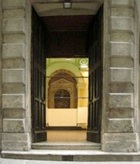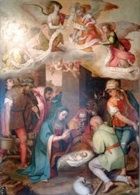

Walk I
Sant’ Isidoro (16th century)
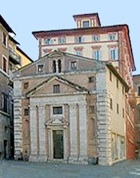
The façade of the present church is attributed variously to Valentino Martelli or Giulio Danti. The inscription on the lintel of the door on the left side reads “Q(ua)m tu es Do(mi)ne spes mea” (in you I trust, O Lord, my hope), and the arms of the Montemelini family are displayed above it.
Palazzo Donini Nuovo (see Santa Maria del Ruscatto below) was built behind Sant’ Isidoro in 1780-6, and its construction required the demolition of its campanile. The project gave rise to strenuous objections from the parish priest of Sant’ Isidoro and from the Sapienza Nuova, to whom the church then belonged.
The church was deconsecrated in the early 20th century and is now used as a shop.
Walk II
Sant' Andrea (1721)
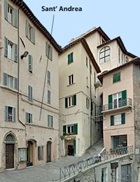
The original site of the church (the present site of the Chiesa del Gesù) was conceded to Cardinal Francesco Armellini in 1520 for a college that he proposed to build. (His death in 1527 led to the abandonment of the project, and the site passed to the Jesuits in 1561).
The monks from Santa Maria di Farneta used this opportunity to demolish the old church and build a new church and small monastery opposite, which gave them a base in the city. The church seems to have been rebuilt in 1721 and served the parish church of SS Lucia ed Andrea from 1788, when the church of Santa Lucia in Via Volte della Pace (see below) was closed.
This parish was abolished in 1871, and Sant' Andrea became an oratory. It was deconsecrated in 1920, and is now in secular use.
San Benedetto Vecchio (11th century)

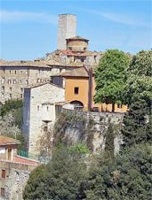
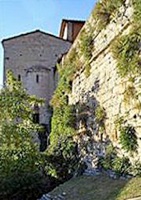
The double church was first mentioned in 1027. By the end of the 13th century it belonged to the Hospitallers of St John of Jerusalem (Knights of Malta).
It was annexed in 1777 to the adjacent Conservatorio Benincasa (a charitable institution housed in the ochre building seen in the central image above).
San Donato (1776)
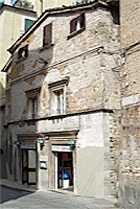
The ex-church now houses a pizzeria.
San Giovanni del Fosso (11th century)
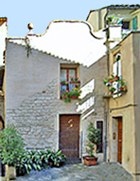
The church was radically remodelled in 1474 and again in the 18th century. It was subsequently deconsecrated and is now a charming house.
Some frescoes (13th century) have recently been uncovered here.
Read more:
P. Scarpellini, “Affreschi Duecenteschi nell' ex-Chiesa Perugina di San Giovanni del Fosso” in:
-
G. Barbera et al. (Eds), “Scritti in Onore di Alessandro Marabottini”, (1997) Rome, pp 33-40
San Giuseppe (12th century)
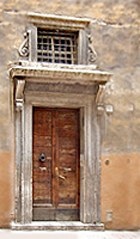
The church (now SS Arigo e Donato) passed to the nearby hospice of Santa Maria della Misericordia in 1402 because it had too few parishioners to maintain an independent existence. It was closed in 1542, at which point its dedication passed to the high altar of the hospice's church.
The Corporazione dei Falegnami (Carpenters’ Guild) moved here in 1597 from Santa Maria degli Aratri in what is now Piazza Cavalotti (below). (Their arms can be seen above the 1st floor windows of number 3 Via Oberdan, further along on the left). They moved to Santa Croce in 1833, when the church was deconsecrated and incorporated into the Ospedale della Misericordia.
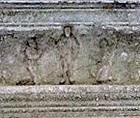
Santa Lucia delle Volte (1547)
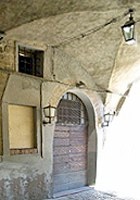
The church was closed in 1788, at which time it was in a poor state of repair. The parish was absorbed by that of Sant’ Andrea (above).
Santa Maria degli Aratri (10th century, demolished 1874)
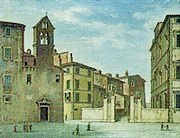
A church here with this dedication was documented in 1105, when it belonged to the Abbazia di S. Salvatore di Valdicastro (near Fabriano in the Marche). It was recorded again in a diploma of the Emperor Frederick I in 1163 as a possession of the Duomo. It was listed as a parish church in 1285.
In 1488, during the war between the Oddi and Baglioni families, members of the former took refuge here. This prompted the Baglioni to set fire to the church, killing a number of people, including a priest. The church was subsequently rebuilt. The Corporazione dei Falegnami (Carpenters’ Guild) moved here in 1597 from san Giuseppe (above).
The church was restored in the 19th century. However, it was demolished in 1874, at which time its facade and campanile were transferred to San Matteo in Campo d’ Orto (below):
-
✴This painting (19th century) by Giuseppe Rossi, which is now in the Galleria Nazionale, shows how it looked shortly before its demolition.
-
✴Photographs in the website “Old Perugia” show Santa Maria degli Aratri looked shortly before its demolition and San Matteo in ca. 1880, after the transfer of the upper part of the facade.
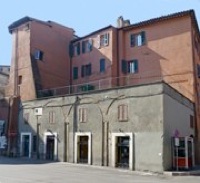
Some remains of the arches in the left wall of the church can be seen incorporated into the right wall of the house at 2-8 Piazza Morlacchi.
Inscription to the Emperor Caracalla (198 AD)
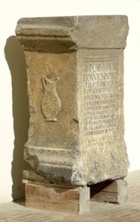
The inscription commemorates the Emperor Marcus Aurelius Severus Antoninus Augustus, who was known as Caracalla in reference to the Gallic hooded tunic he usually wore. It is dated to his second period as Tribune, when his father was the emperor: Caracalla did not succeed him until 211 AD. The inscription sets out his genealogy and notes that the Decurioni (magistrates of the municipium) erected the altar.
Santa Maria della Valle (11th or 12th century)
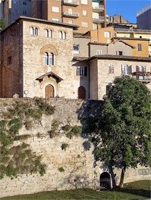
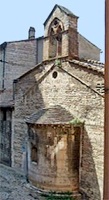
This was the site of an ancient hermitage that was listed as a possession of the Benedictine Abbazia di Santa Maria di Farneta (near Cortona) in a privilege issued by the Emperor Henry II in 1014. It was documented again among the abbey’s possessions in a bull of Pope Gregory IX in 1238, and as a parish church in 1285. A community of Carmelites settled at an ancient oratory here in the 13th century, before moving to San Simone del Carmine in 1296.
The parish was suppressed in 1733 and the church passed to the Compagnia dei Muratori (builders’ guild) in 1760. They remodelled the interior in 1771 and dedicated it to their patron saint, St Marinus. It reverted to its original dedication when the guild was disbanded in the 19th century.
Sister Léonie Aviat and her sisters from the came here in 1903 when their order, the Oblate Sisters of St Francis de Sales, was expelled from France. She died here in 1914 and her remains lay in the Cimiterio Civico until 1928, when they were translated back to the church. They were translated again to the mother-house of the order in Troyes in 1961, and she was canonised in 2001.
The façade of the church was rebuilt in 1921 by Ugo Tarchi, who re-used some of the original bifore windows. The semicircular apse (13th century) of the earlier church can be seen from Via della Luna, which is to the left.
San Martino del Verzaro (11th century)

Madonna and Child with saints (16th century)
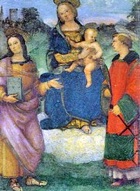
Walk III
Sant’ Antonino (12th century)
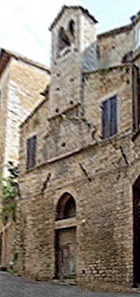
However, Santa Croce was also in poor condition and it was subsequently decided to restore Sant’ Antonino. The newly restored church assumed both dedications in 1825.
Santa Croce (12th century)
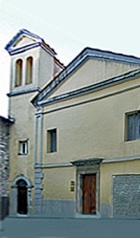
-
✴Pope Innocent III confirmed it as a possession of San Pietro, Gubbio in 1199.
-
✴It was listed as a possession of the Abbazia di San Bartolomeo di Camporegio, outside Gubbio in 1218.
-
✴In 1417, Pope Martin V gave it to the Olivetans.
In 1802, it assumed the additional dedication of the nearby church of Sant' Antonino (above), at which point the Olivetans lost control of it. However, its roof threatened to collapse shortly afterwards. It was therefore decided to restore Sant’ Antonino, and this newly restored church assumed both dedications in 1825.
Santa Croce, which has been remodelled on a number of occasions, owes its current bland appearance to a remodelling carried out in the late 19th century. It is now used as a Greek Orthodox church.
San Giovanni Battista (1607)
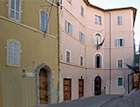
In 1801, Pope Pius VII incorporated a number of the surviving Cistercian communities in the Papal States into a revived Congregazione di San Bernardo. The Abbazia di Santa Maria di Valdiponte, Montelabate, which became part of the new congregation, took over San Bernardo, which they re-opened and re-dedicated as San Giovanni Battista. [Were they called "i Padri Zocchetti" (wearers of clogs)??]
The congregation was suppressed during the Napoleonic occupation, but revived in 1814. It was suppressed again, this time definitively, in 1871. At this point, the complex was redeveloped as public offices. It now houses the Department of Linguistic Science of the University and the Regional Treasury.
San Gregorio (11th century, now demolished)
This church was documented in 1073 and was listed as a parish church in 1285. In 1548, Cardinal Federico Cesi (who held Santa Maria di Valdiponte in commendam) transferred it to the secular clergy. It passed to the nearby Cistercian monastery of San Bernardo (see San Giovanni Battista, above) in 1615.
Pope Urban VIII authorised the suppression of the parish in 1624. It was absorbed by that of San Giovanni Rotunda, which was administered by the Oratorian Fathers of San Filippo Neri. It fell into ruin and was sold in 1774 to a private family that was obliged to maintain part of it as a chapel. It was finally de-consecrated in 1874 and subsequently subsumed by the surrounding buildings.
San Matteo in Campo d' Orto (12th century)
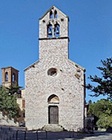
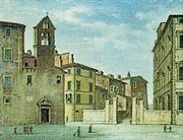
San Matteo Santa Maria degli Aratri
This church and the surrounding land are listed among the possessions of the Eremo di Fonte Avellana, outside Gubbio in a privilege granted by Pope Honorius III in 1218. The complex was transferred to the Franciscans in 1256 after fierce resistance. They built a convent here and probably used the church for their own services, at least for a period. After they had built the adjacent church of San Francesco al Prato, San Matteo became their cemetery church.
In 1876, when Santa Maria degli Aratri (see above) was demolished, its campanile and the upper part of its facade were transferred to San Matteo, which then underwent restoration:
-
✴The painting (19th century) above by Giuseppe Rossi, which is now in the Galleria Nazionale, shows how Santa Maria degli Aratri looked shortly before its demolition.
-
✴Photographs in the website “Old Perugia” show Santa Maria degli Aratri looked shortly before its demolition and San Matteo in ca. 1880, after the transfer of theupper part of the facade.)
San Matteo, which is now de-consecrated, belongs to the University of Perugia.
Walk IV
San Claudio (1476, destroyed in 1798)
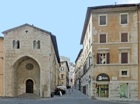
Madonna and Child with saints (ca. 1573)
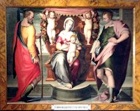
Cappella di San Giacomo (ca. 1285, extended in 1502)


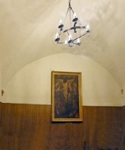
A small parish church that belonged to the Abbazia di San Pietronear the eastern arch of the Due Porte (subsequently in the inner face of Porta San Pietro) was first documented in 1285. It was annexed to the nearby Ospedale di San Giacomo (1394) as its chapel in ca. 1400, at which point the complex passed to the Collegio del Cambio.
With the completion of the outer face of the gate in 1481, the chapel found itself inside the double structure. In 1502, Amico Graziani, the prior of the Collegio del Cambio, complained to the Commune that this narrow space was inconvenient, especially since the church shared it with a slaughterhouse. The authorities agreed to his proposals for the amplification of the chapel, which involved the closing of the eastern arch of the inner gate so that the facade of the chapel could be moved forward. The inscription above the new portal bears the date of this remodelling. The authorities also agreed that the chapel should formally revert to its earlier status as a church. However, the slaughterhouse remained in use until at least 1596.
The Confraternita di San Pietro Apostolo used the chapel for a period until 1579, when it moved to a new oratory near Santa Maria di Colle.
The chapel, which was restored again in 1765, is now closed but sometimes used for concerts.
Crucifixion with saints (17th century)
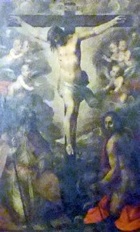
Santa Lucia di Colle Landone (16th century)
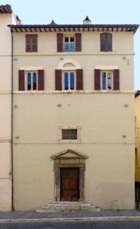
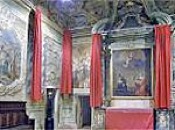
The original church with this dedication, which was first documented in 1022 as a possession of the Abbazia di San Pietro, stood on what is now the site of Palazzo Donini. This church, which was listed as a parish church in 1285, was demolished in ca. 1540 to make way for Rocca Paolina.
In 1567, the parish (which had itself been reduced because of the demolition) was merged with that of SS Donato e Arrigo. The church of Santa Maria della Misericordia, which had already taken over the role of the old parish of SS Donato e Arrigo (and had absorbed its church), now also assumed responsibility for the parish of Santa Lucia.
Bishop Fulvio della Corgna built a new church on this site in Via Baglioni with apartments were above it for old and sick priests. The church was originally dedicated as Santa Maria del Clero, but its dedication was changed when it acquired the goods and title of the demolished Santa Lucia in 1584 (despite the claims of the Abbazia di San Pietro).
The church owes its present appearance to a remodelling in 1760.
Santa Maria di Braccio (1476-9)
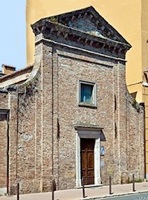
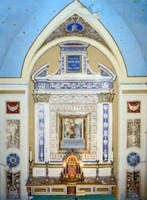
Braccio di Malatesta Baglioni built this church on land that belonged to the Abbazia di San Pietro. It originally housed an image of the Virgin that had apparently performed miracles during an outbreak of plague in 1476. The Servites of Santa Maria dei Servi originally officiated here, having reached an accord with the monks of San Pietro.
The church was originally octagonal but its façade was partially rebuilt in 1782 to conform to the surrounding buildings when Borgo XX Giugno was widened. The interior was partitioned at this point to give its current rectangular form.
The sacristan of San Pietro can sometimes open the church by appointment.
Madonna and Child (ca. 1502)
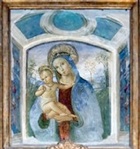
The sides of the niche are decorated with frescoes candelabra. The original fresco of the upper tondo has been lost.
Walk V
San Cristoforo (13th century)
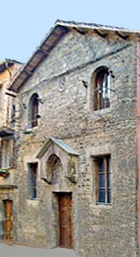
The arms of the Maestri di Pietra e Legname (the guild of stone masons and carpenters), which depict a pair of compasses and a set square, can be seen below the string course, which suggests that they owned the church at some time.
San Fortunato (12th century)
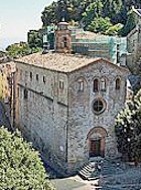
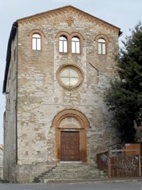
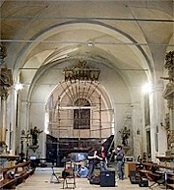
San Fortunato was first documented in 1163 as a dependency of the Duomo.
It was a parish church by 1285. The facade retains some of its 13th century features.
A community of Sylvestrine monks came here in 1377 after fire had destroyed their original monastery of Santa Maria di Porta Sole (later Santa Maria Nuova) during the riots attending the destruction of the Fortezza di Porta Sole. They built a new monastery behind the church. Some of the monks returned to what was left of their old monastery in 1404, while others remained at San Fortunato. The community was reunited here in ca. 1540, when Santa Maria Nuova passed to the Servites from Santa Maria dei Servi. San Fortunato remained a Sylvestrine monastery until 1989.
The campanile (16th century) can be seen above the buildings of the ex-monastery behind. The church,was remodelled in 1663: the stucco decoration of the altar, for which Bino Sozi was paid in 1584, was presumably destroyed at this time. The church is now closed, but is occasionally used for concerts.
Madonna and Child with saints (1584-5)
This panel by Silla Piccinini, which depicts the Madonna and Child with SS Fortunatus and George, was originally painted for the new high altar. It is now on the back wall of the choir there.
Altars (17th century)
The four gilded wooden altars on the side walls are by Léonard Chailleau (Leonardo Scaglia, il Francese).
Cappella della Madonna della Stella (14th century)
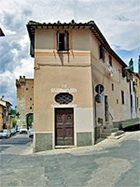
It is apparently open on the Feast of St Michael (29th September).
Santa Maria Consolatrice degli Afflitti (1748)
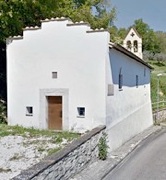

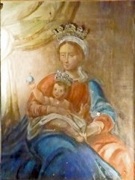
This small church was built outside Porta Bulagaio to house a miraculous image (18th century) of the Madonna and Child. Local people wold gather dust from the niche that housed this image, place it in a small cloth and hang it in front of the image in order to cure afflictions. The dedication refers to the Virgin as the comforter of the afflicted, and the alternative name of Santuaria della Madonna dei Cenciarelli refers to the small cloths in which the miraculous dust was traditionally placed.
The church is only during the feast of the Our Lady, Consoler of the Afflicted (29th August). (These pictures were taken during the celebration in 2013).
Walk VI
Santa Maria delle Grazie di Monterone (1534)
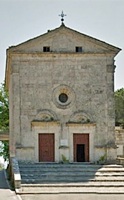
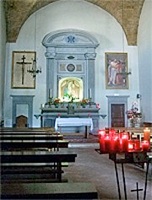
The legend of St Florentius has him buried in a church dedicated to the Virgin, and local tradition identifies this as the ancient church of Santa Maria di Monterone. The relics of St Florentius were translated at some point, presumably for greater safety, to San Fiorenzo.
-
✴San Fiorenzo had been in the possession of the Camaldolesian Abbazia di San Salvatore di Monte Acuto since at least 1059.
-
✴The church of Santa Maria in Clevi (probably Santa Maria di Monterone), was listed immediately after San Fiorenzo in a list of the possessions of San Salvatore that Pope Eugenius III confirmed in 1145.
Santa Maria di Monterone was still listed among the possessions of San Salvatore in 1495, by which time San Fiorenzo had been transferred to the Observant Servites.
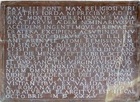
Another inscription records that the church was restored after a fire in 1961 and reconsecrated in 1969. It now serve the nearby Cimitero Civico (cemetery).
Madonna and Child (14th century)

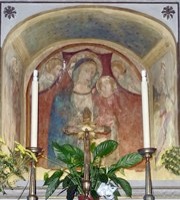

This venerated (albeit heavily repainted) fresco in the aedicule above the high altar probably came from a wayside tabernacle. It depicts the Madonna and Child enthroned, with
-
✴SS Antony Abbot and Nicholas to the left; and
-
✴the martyrdom of St Florentius to the right.
Santa Maria della Pace (1571-3)
This was originally the site of Benedictine nunnery of Santa Cecilia (1279).
The nunnery had been abandoned by 1570, when Cardinal Fulvio della Corgna gave the site to the Capuchins, who were already established at Montemalbe, outside the city. The new foundation became known as the “Luogo Nuovo” (new place), to distinguish it from the original settlement.
The Capuchins built a new church, which they dedicated in honour of the peace that followed the papal victory against the Turks at the Battle of Lepanto (1571).
The complex was subsequently demolished and the site now houses the Clinica Neurologica del Policlinico di Perugia.
Art from the Church
Adoration of the Shepherds (1579)
Adoration of the Shepherds (17th century)
This altarpiece, which is signed “SIMEON BEVILACQUA DE CIBURRIS”, was documented in the choir in ca. 1671 and again in 1822. (The form of the signature establishes the fact that Simeone Ciburri enjoyed the patronage of Cardinal Bonifazio Bevilacqua). The altarpiece is now in the parish church of Antria, near Magione.
Santa Maria Maddalena (1285)
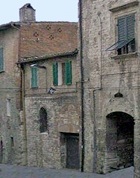
The church was still in the possession of the Franciscan tertiaries in 1327. It was documented as a possession of the Eremo di Fonte Avellana, outside Gubbio in 1345. However, the Franciscan tertiaries undertook a long and ultimately unsuccessful legal case against Angelo di Lorenzo, who was described as the chaplain of Santa Maria Maddalena, in the period 1368-84 over the ownership of the complex.
In 1404, Pope Boniface IX gave the church and adjacent houses to the Olivetans of Montemorcino (later Montemorcino Nuovo), and they initially used the houses as a hospice. They soon sold these houses, but they retained ownership of the church until 1796. It was then de-consecrated and adapted for secular use.
The arch to the right of the ex-church leads to a courtyard with two portals (one in front of you and another to the left). Each of these had the arms of the Olivetans on its lintel, but these were subsequently removed.
Read more about Santa Maria Maddalena:
The early history of this complex is difficult to piece together, and I might have misunderstood some aspects of it. If you have a particular interest, please consult the following original sources:
G. Casagrande, “Penitenti e Disciplinati a Perugia e loro Rapporti con gli Ordini Mendicanti”, Mélanges de l' Ecole Francaise de Rome", 89 (1977) 431-44
U. Nicolini, “I Frati della Penitenza a Perugia alla fine del Secolo XIII”, in:
“Il Movimento dei Disciplinati nel Settimo Centenario dal suo Inizio: Atti del Convegno Internazionale”, (1962) Perugia, pp 371-80
Walk VII
Sant’ Angelo in Porta Eburnea (11th century)
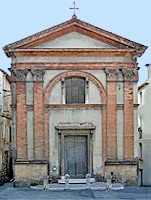

The church, which belonged to the Benedictine Abbazia di Pomposa (near Ferrara), was listed as a parish church in 1285. It passed to episcopal control in 1558.
The church is apparently open for Mass on saturdays (16.30-19.00) and Sundays (11.00-12.00).
Exterior
The neo-Classical facade was imposed in the early 19th century.
The right side of the church is much older, and stands on foundations of huge blocks of stone, leading to the campanile above the apse.
Altarpieces (ca. 1745)
Cristoforo Gasperi apparently sent two altarpiece from Rome to Perugia for altars in the church:
-
✴SS Michael, Ursula and Francis di Sales, for the high altar; and
-
✴the Madonna and Child with SS Lucy and Apollonia.
[Are they still there ?]
St John of the Cross (18th century)
This panel in the deposit of the Galleria Nazionale, which is of unknown provenance, is attributed to Francesco Busti. The kneeling saint is surrounded by angels, one carrying a cross and one (a baby) carrying lilies. This might be one of two (otherwise unknown) panels that Baldassarre Orsini attributed to this artist in his guide of 1784:
-
✴a panel in Sant’ Angelo in Porta Eburnea, which he identified as portraying St John Nepomucen; or
-
✴a panel in Santa Teresa, which he described as “St John of the Cross with many angels, and with the Eternal Father and Jesus Christ above” (although these upper figures are missing).
San Giacomo (13th century)
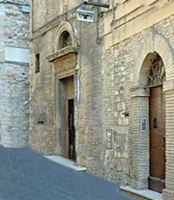
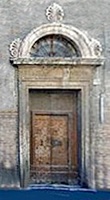
This church, which is dedicated to the patron saint of the Rione di Porta Eburnea, was first documented in 1246. It was listed as a parish church in 1285. The Servites occupied adjacent houses from the time of their arrival in the city in 1255 until their move to Santa Maria dei Servi in 1313.
The Compagnia delle Cinque Piaghe, an association of penitents dedicated to the five wounds of Christ, had their headquarters here for a period, possibly from the time of the Bianchi march of 1399. Until the 17th century, they marched in procession every 25 years on Good Friday carrying a Crucifix that was usually kept on the high altar of the church.
The church was remodelled in 1638 and again in 1818. It was subsequently deconsecrated, but its portal, which has interesting palmate decoration, survives.
St James (18th century)
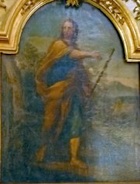
Santa Maria del Riscatto (1657)
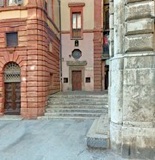
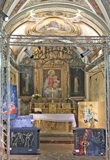

The church, which is also known as Santa Maria di Colle Landone, stands on the site of a shrine (15th century) that contained an image of the Madonna and Child known as the Maestà degli Schiavi (of the slaves). This shrine stood in what was then an alley between Via della Forte and the present Corso Vannucci.
The image performed various miracles in the 16th century, which led to the formation of the Compagnia di Santa Maria del Riscatto (of the ransomed) in 1585. The young nobles who formed this society built an arch across the alley, thereby enclosing the shrine. Two years later, they built walls across the alley to create a small chapel.
The company, which was reconstituted as the Compagnia della Santissima Maria della Mercede in the 17th century, acquired some adjacent buildings and built the present church. The original Palazzo Donini was built to the right of it in 1716-24. Costanza Baldeschi, the widow of Luigi Donini, built a new palace, Palazzo Donini Nuovo, which incorporated the church, in 1780-6. It was documented as the Oratorio Donini in 1851.
The ex-church, which now belongs to the Opera Apostolica di Perugia, is occasionally used for exhibitions (as in the photograph above). [Is the panel on the high altar the original miraculous image ??]
San Nicolò, later San Giorgio dei Tessitori (demolished)
A church here (“ecclesiam Sancti Nicolai de Parione”) was listed as a possession of the Benedictine Abbazia di Santa Maria di Farneta (near Cortona) in a privilege issued by the Emperor Henry II in 1014. It was documented again among the abbey’s possessions in a bull of Pope Gregory IX in 1238. It functioned as a parish church from the 13th century until 1628, when the parish was suppressed. It was then re-dedicated as San Giorgio, the patron saint of Genoa and of the Compagnia dei Tessitori, a guild of Genoese weavers. The guild, which had been established here in 1575 and continued to use the church until its demolition in 1878 to make way for the new the Istituto di Pena Maschile (men’s prison).
Frescoes (1498)
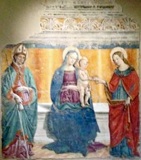
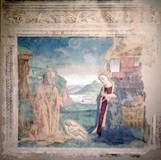
These damaged frescoes, which are dated by inscription and attributed to Fiorenzo di Lorenzo, were detached in 1878, just before the church was demolished. The surviving fragments exhibited in Room 24 of the Galleria Nazionale depict:
-
✴the mystic marriage of St Catherine, with St Nicholas of Bari; and
-
✴the Nativity, in which the new born baby Jesus lies naked in a meadow in front of the stable, venerated by the kneeling Virgin and St Josep.
Other fragments in the deposit of the gallery depict figures of SS Sebastian, Francis and John the Baptist.
SS Savino e Cataldo (16th century)
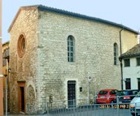
The church was deconsecrated in the 19th century and its dedication, along with that of the deconsecrated church of SS Stefano e Biagio (below) passed to SS Biagio e Savino in Piazza Leone III on the outskirts of Perugia.
SS Stefano e Biagio (12th century)
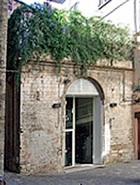
At some point, this church passed to the Sapienza Nuova: it was deconsecrated in 1829 when this college moved to the site of the Sapienza Vecchia. Its dedication, along with that of the deconsecrated church of San Savino (later SS Savino e Cataldo - above) passed to SS Biagio e Savino in Piazza Leone III on the outskirts of Perugia.
Madonna and Child with saints (ca. 1644)
Ottavio Lancellotti recorded in his “Scorta Sagra” (17th century) that Antonio Maria Fabrizi had painted this altarpiece for his family chapel in SS Stefano e Biagio. When this church was deconsecrated in 1829, the altarpiece was moved to SS Biagio e Savino in Piazza Leone III on the outskirts of Perugia. The altarpiece (which is illustrated in the website of the Fondazione Federico Zeri) depicts the Madonna and Child in glory with SS Octavian and Apollonia (who holds the pincers with which her teeth were torn out).
Chiesa del Suffragio (1639)
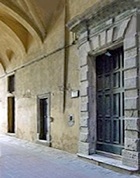
The building is now deconsecrated, but the original portal and a stone offertory survive on the façade. The inscription above the offertory solicits donations to finance the celebration of Masses for souls in purgatory.
[Retains some original decoration inside]
Frescoes (1641)
These documented frescoes by Antonio Maria Fabrizi in the chapel in this church that belonged to Sebastiano Fiori have been destroyed.
Madonna and Child with saints (17th century)
